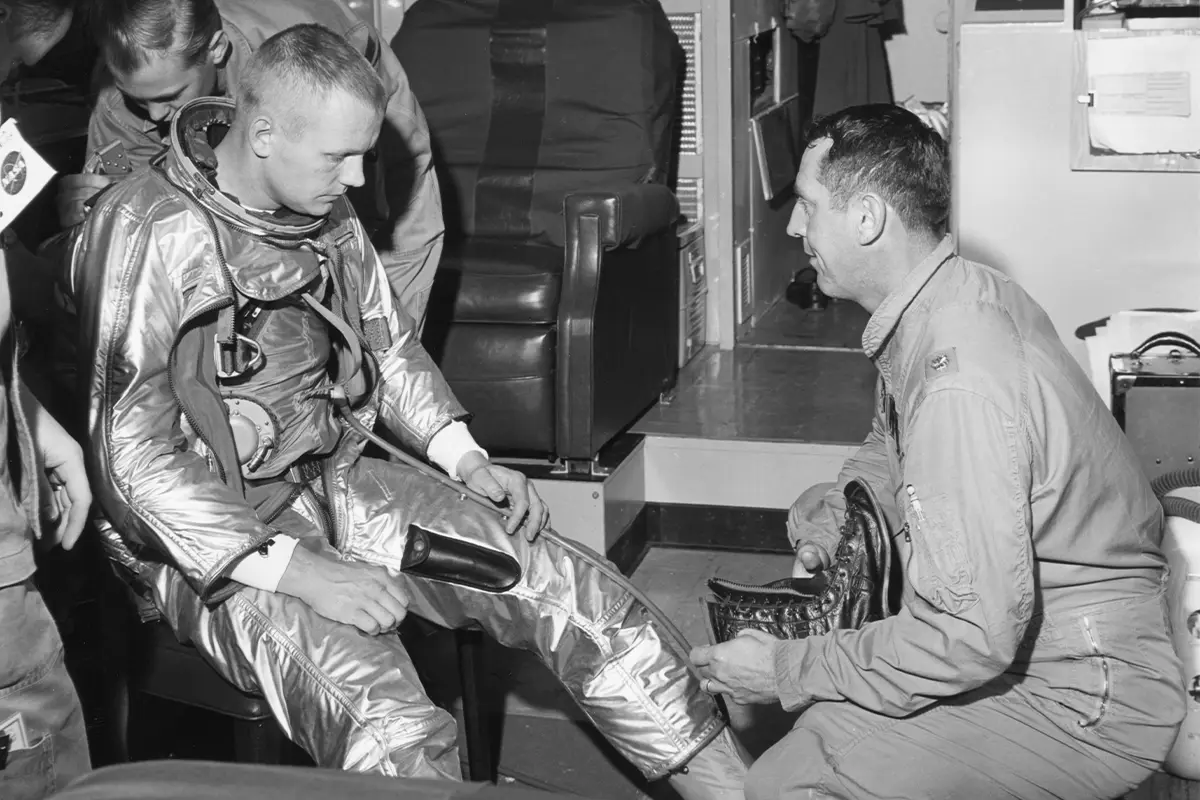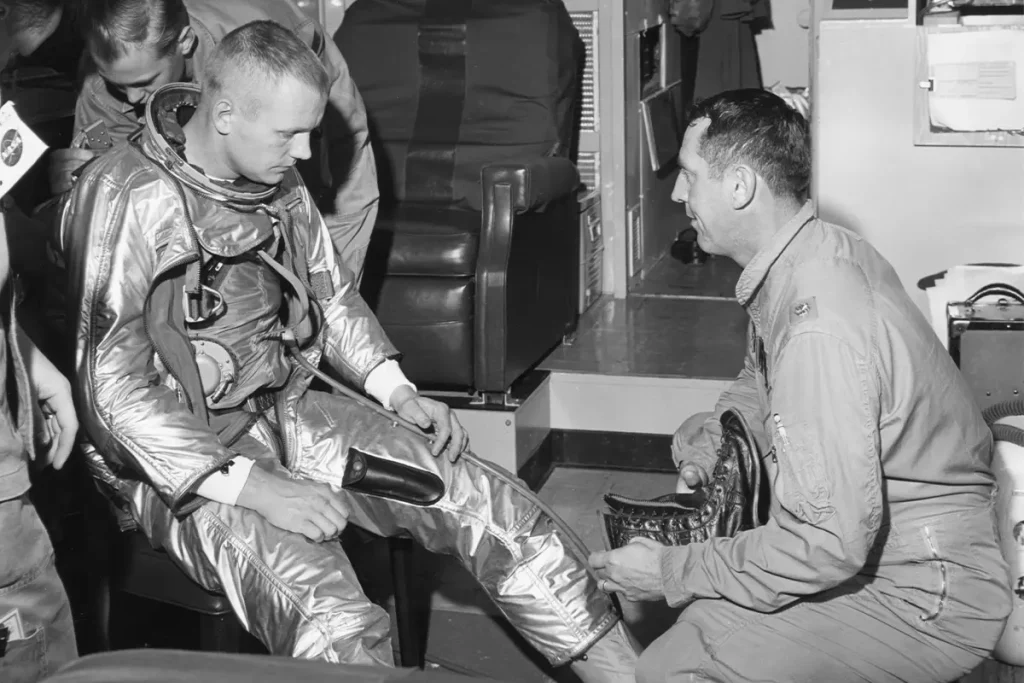Prada’s venture in space wear: AxEMU (Axiom Extravehicular Mobility Unit) a legacy of innovation in the use of raw materials, nylons, and manufacturing technology. NASA’s Artemis III mission
Prada x Axiom Space set to design spacesuit technology for NASA’s Artemis III Mission – first mission on the Moon since 1972
Prada is set to design the spacesuits for NASA’s Artemis III lunar mission. Scheduled for late next year or early in 2025, this mission not only signifies a pivotal moment in space exploration but also introduces the first woman, NASA astronaut Christina Koch, and the first person of color, Victor Glover, to walk on the lunar surface. The two astronauts will join Reid Wiseman and Jeremy Hansen to fly a capsule around the Moon.
The aim of this expedition is to capture images and videos of the lunar surface, conduct geological surveys, and gather diverse samples from the southern lunar pole. Last lunar mission, on board Apollo 17, took place in 1972.
What are spacesuits made of? The construction, textiles and raw materials functioning in space – NASA’s Extravehicular Mobility Unit (EMU)
A spacesuit is made up of several components and layers, each using specialized synthetic raw materials to provide comfort and a breathable atmosphere with oxygen, to ensure astronauts survive without Earth’s protective atmosphere. NASA’s Extravehicular Mobility Unit (EMU) spacesuit manufacturing technology must be created to maintain stable internal pressure, allow mobility for tasks, supply oxygen and eliminate carbon dioxide, regulate temperature in different light conditions and shield against solar radiation.
It is assembled in layers: the first is a cooling layer: like an undergarment, the cooling layer made of stretchy Spandex, regulates temperature and reduces moisture during strenuous activities. It includes water hoses to regulate temperature, and like any other long-chained polymer, possesses excellent elastic properties.
Once the space suit is put on, it is composed of various layers with different functions: the inside bladder, constructed from polyurethane-coated nylon, it holds gas for breathing, ensures airtightness and water resistance; the restraint, made from polyester fabric, maintaining the bladder layer’s position and conforming to the astronaut’s body; a ripstop layer: a tear-resistant layer safeguarding the suit’s integrity; and finally insulation layers, that are crafted from mylar, a polyester film, retaining body heat within the suit.
The outer layer of NASA’s Extravehicular Mobility Unit (EMU) is designed to reflect sunlight and uses threads, each with a specific function: Teflon for water resistance, Nomex for fire resistance, and Kevlar for flame resistance. In the upper part of the space suit, the hard upper body case, made from fiberglass, connects the spacesuit’s components and the helmet, spheroidal dome-shaped, which provides a wide field of view, pressure compensation, and low weight. The visor is coated with gold to reflect infrared and ultraviolet rays while permitting visible light, protecting against solar radiation.
The Extravehicular Mobility Unit (EMU) technology: suit composition manufactured by Hamilton Standard, Collins Aerospace
The Extravehicular Mobility Unit (EMU) is an autonomous anthropomorphic spacesuit designed to offer environmental protection, mobility, life support, and communication for astronauts engaged in extravehicular activity (EVA) in Earth’s orbit.
Introduced in 1981, it comprises a two-piece semi-rigid suit and is currently one of the two types of EVA spacesuits utilized by crew members on the International Space Station (ISS), with the other being the Russian Orlan space suit. NASA’s Space Shuttle astronauts utilized it until the conclusion of the Shuttle program in 2011.A fully equipped Extravehicular Mobility Unit (EMU) can sustain an astronaut for 8.5 hours, with 30 minutes of reserves in case of primary life support failure.
The Extravehicular Mobility Unit (EMU) is a culmination of 21 years of research and development. Manufactured by Hamilton Standard (now part of Collins Aerospace) in Connecticut for hardware and accessories and by ILC Dover in Delaware for soft components, the Extravehicular Mobility Unit (EMU) underwent development in collaboration after the contract was secured in 1974.
A total of 18 EMU suits with PLSS were manufactured, with some lost during missions and testing, leaving 11 functional units as of 2017
In history, the first Extravehicular Mobility Unit (EMU) units were delivered to NASA in 1982, with initial testing facing challenges such as a suit catching fire, leading to a redesign. The first Shuttle EVA occurred on STS-6 in 1983, and subsequent EVAs became integral to various missions, including those servicing the Hubble Space Telescope. With the ISS, the EMU was modified for modular use, allowing it to be left on the station for extended periods and resized to fit different crew members.
Presently, the ISS EMUs, alongside Russian Orlan suits, are used by crews of various nationalities on the ISS. In the most recent years, NASA has used the Exploration Extravehicular Mobility Unit (xEMU) system during the Artemis program. On June 1, 2022, NASA announced the selection of Axiom Space and Collins Aerospace to develop and provide astronauts with the next generation of spacesuit and spacewalk systems for missions outside the ISS, lunar exploration under Artemis, and preparation for human missions to Mars.
Prada and Axiom Space present the AxEMU (Axiom Extravehicular Mobility Unit): the advanced version of NASA’s space suit – the use of composite materials
The Prada and Axiom Space suit is called AxEMU (Axiom Extravehicular Mobility Unit), and represents an evolution of NASA’s Exploration Extravehicular Mobility Unit model. The AxEMU (Axiom Extravehicular Mobility Unit) is designed to provide more mobility for astronauts to explore space and study ways humans could live and work on and around the Moon. While Axiom Space suits already have enhanced flexibility and are designed to survive adverse atmospheric conditions, Prada will contribute to material development and final external shell refinement.
In mid-March of this year, Axiom Space presented the first prototypes of the AxEMU (Axiom Extravehicular Mobility Unit) space suits in black. The color, like many prototypes like this before, will be temporary, as it was used to conceal the manufacturing technology before the release of the final version, which will be white once again, reminiscent of the Apollo missions.
Prada’s primary focus lies in the outer layer of the spacesuit. Michael Suffredini emphasizes leveraging Prada’s expertise in composite materials, aiming to make the space suit components lighter, enhancing astronauts’ mobility. Prada’s expertise in raw materials, production techniques, and design will allow them to apply advanced technologies considering human factors that are as necessary as they are currently absent in traditional spacesuits.
Prada’s expertise with raw materials and production techniques – Composite materials and nylon in Prada’s DNA: From the Linea Rossa collection to Extreme-Tex and Re-Nylon
Prada has a longstanding proficiency in working with composite materials, a legacy that traces back to the 1990s when they established the Luna Rossa yachting team for participation in the America’s Cup. The collection not only featured a prominent use of nylon, incorporating padded shirts and bucket hats crafted from the brand’s signature fabric, serving as a precursor to the upcoming AW18 womenswear show the following month.
Just as Prada adeptly tapped into the futuristic optimism of the 1990s, where technical fabrications and minimalist silhouettes became a wardrobe essential as popular culture transitioned into the new millennium, the decision to revive this line might have something to do with the spacesuit design and the manufacturing technology required for the collaboration with Axiom Space.
In 2020, the latest reprise of the Linea Rossa collection, Prada featured the raw material Extreme-Tex, which is not only lightweight and structured but also boasts water-repellent and durable properties. Designed for functionality, it regulates body temperature and features antibacterial attributes integrated into the fibers to manage incidental sweat. Notably, the production processes for this material are sustainable and non-polluting, omitting harmful compounds typically associated with waterproofing, such as perfluorocarbons.
Manufacturing Technology – AxEMU (Axiom Extravehicular Mobility Unit) space suits – the forefront of fabric technology is Prada’s Re-Nylon
Available in two weights, standard and light, the fabric is used in crafting men’s overcoats and trousers, as well as women’s tees. Alongside Extreme-Tex, the collection incorporates other regenerated yarns like stretch jersey and nylon.
Ultimately, the objective for the AxEMU (Axiom Extravehicular Mobility Unit) space suits is optimal mobility, an area where Prada excels. Another example of the forefront of fabric technology is Prada’s Re-Nylon, a textile that can be perpetually regenerated without compromising quality.
Prada’s Re-Nylon comes exclusively from regenerated nylon, employing a process involving depolymerization, purification, transformation into new polymers, and subsequent thread production, this material allows for continuous recuperation and transformation into fresh nylon fabric. Prada’s outer layer of the space suit currently remains undisclosed.
Axiom Space
Axiom Space is an American company committed to building human-rated infrastructure with the aim of fostering a platform that supports human existence in outer space.




















